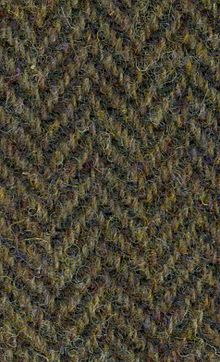Tweed
Tweed is a textile fabric that is not named after the river Tweed in Scotland, as is often claimed, but after the Scottish word tweel, which is synonymous with the English word twill and denotes a type of weave that is called twill weave or likewise "twill" in German.
Originally, tweed was used to describe hand-woven, usually twill-band fabrics that were tightly woven but flexible. Tweeds were developed as protection from the elements in the harsh climate of the British Isles. For the pastimes of the landed gentry, such as hunting, riding, shooting, and fishing, tweed was the ideal clothing for a long time. However, tweeds were also the usual clothing for sporting activities such as cycling, golf, tennis, motor sports and mountaineering during the Victorian era.
The fabric is used, for example, with traditional plaid patterns, tartans, as a material for kilts. Tweed is used as a fabric for costumes, coats, jackets, suits and hats. In addition, there are products such as curtains, sofa cushions, furniture covers, dog blankets, shoes, bags and various accessories made of tweed. Today's tweeds have very different properties, depending on the types of wool used, thread count and fabric weight. Tweeds come in countless colors, patterns and names. Some tweeds contain other animal hair besides wool, such as camel hair, mohair, cashmere and alpaca.
- Tartans: Plaid fabrics that express an affiliation to a certain Scottish clan through colors and patterns. Some companies also have their own tartans.
- Estate Tweeds go back to the owners of certain estates, who often chose colors and patterns that particularly fit the landscape so as not to be seen when hunting. Estate Tweeds became popular with landowners through Prince Albert's invention of the Balmoral Tweed, which is based in color on the landscape and the color of Balmoral Castle. Originally, the wearing of such tweeds was limited to the family and staff of the landowners, but today anyone can wear them.
- Cheviot tweeds are named after a breed of sheep whose wool is used. The yarns are thicker, rougher and heavier, the cloths are usually more densely woven and stiffer than other tweeds.
- Shetland Tweed, named after the islands, a tweed made from particularly soft wool as produced in Shetland.
- Donegal Tweed, named after the northernmost Irish County Donegal where this traditional tweed is still partly woven by muscle power, is characterized by small colored knots in the fabric.
- Harris Tweed is a brand name for a hand-woven fabric from the Outer Hebrides under the Harris Tweed Act of 1993. An open, airy tweed that is rough to the touch and only softens with wear.
- Saxony Tweed: A tweed made of fine and soft merino wool
- Thornproof Tweed is a fabric made of extra strong twisted yarn, which is particularly resistant to puncturing and tearing. The fabric is self-healing; a puncture disappears by itself when the fabric is massaged a little.
- Sporting Tweed is a tweed that has particularly good camouflage properties, as used in hunting. Many Estate Tweeds are such Sporting Tweeds, adapted to the climate and colors of the landscape. The many colors of different landscapes and the urge to innovate and distinguish produced countless varieties and patterns of tweeds.
- Gamekeeper Tweed is a particularly heavy tweed and can reach fabric weights up to about 1000 g. This tweed is intended for increased protection of gamekeepers on particularly cold, wet and windy days.
· 
The golfers Old Tom Morris and Young Tom Morris in tweed suit
·
Donegal Tweed, characteristic are the small knots of colored wool
· .jpg)
The colors and patterns are inexhaustible
·
Prince of Wales pattern

A piece of Harris Tweed in herringbone pattern

Fabric pattern in check pattern
Questions and Answers
Q: What is tweed?
A: Tweed is a rough, woollen fabric with a plain weave, twill or herringbone pattern.
Q: How are colour effects achieved in tweed?
A: Colour effects in tweed are achieved by mixing dyed wool before it is spun.
Q: What are tweeds an icon of?
A: Tweeds are an icon of traditional Scottish and Irish clothing.
Q: What is tweed good for?
A: Tweed is good for informal outerwear because the material is moisture-resistant and long-lasting.
Q: What are tweeds made to withstand?
A: Tweeds are made to withstand harsh climates.
Q: For what outdoor activities are tweeds often worn?
A: Tweeds are often worn for outdoor activities such as shooting and hunting.
Q: Where is tweed making done in Ireland and Scotland?
A: In Ireland, most tweed making is done in County Donegal, while in Scotland, tweed is associated with the Isle of Harris.
Search within the encyclopedia

